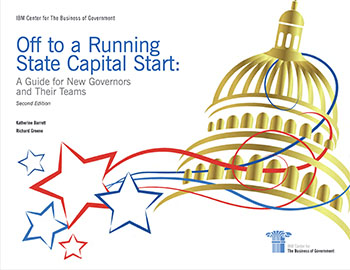This post first appeared on IBM Business of Government. Read the original article.

Voters in 36 states elected 9 new governors the fall. What can new governors do in their first year to build for a successful term?
To help leaders in new Governors’ offices across the initial months of a new term, the IBM Center for The Business of Government has released a second edition of a prior report, Off to a Running State Capital Start: A Guide for New Governors and Their Teams. Written by leading experts on state government management and Center Visiting Fellows Katherine Barrett and Richard Greene, the guide makes recommendations in three areas:
- Leverage your state government’s existing executive talent
- Treat your state government as an integrated enterprise
- Organize decision making to achieve results
As the report outlines, numerous differences between states will impact how a new governor carries out first-year priorities. These differences include the power balance between the governor and the legislature, authority to take executive action, and the role that boards and commissions play in State governance.
Looking across the State playing field, Barrett and Greene make numerous key findings with advice for governors and their staff:
- State executive leaders must actively engage legislators and other elected leaders early to solidify a collaborative and productive relationship. builds buy-in that leads to positive results throughout a term of office.
- The new administration should seek whether it can build on initiatives of previous administration that are consistent with their priorities, and not make change only to turn a page. Whether or not there has been a party change in the Governor’s office, programs that have worked can often move forward.
- The new administration should build connections with local and national government leaders, and with career experts and teams continuing to serve in state government.
- New gubernatorial staff should understand how their priorities relate to past management and technology/data reform initiatives to foresee barriers and how to overcome them, which may be contained in the work of efficiency commissions, performance and oversight reports, expert papers, and technology studies.
- The governor should track current legislative agenda items, to make the most out of interactions during legislative sessions in the first year.
- Governors should foster agile innovation across policies, programs, and build a culture of experimentation and risk taking — with support for failing fast and early in a way that provides learning and improvement opportunities, as opposed to failing large and too late to make an adjustment.
- Incoming teams should assess progress of first-year efforts, and keep stakeholders and the public informed of achievements, obstacles, and improvement plans.
The authors also address how to implement these recommendations with expert advice for new state agency heads and their teams.

